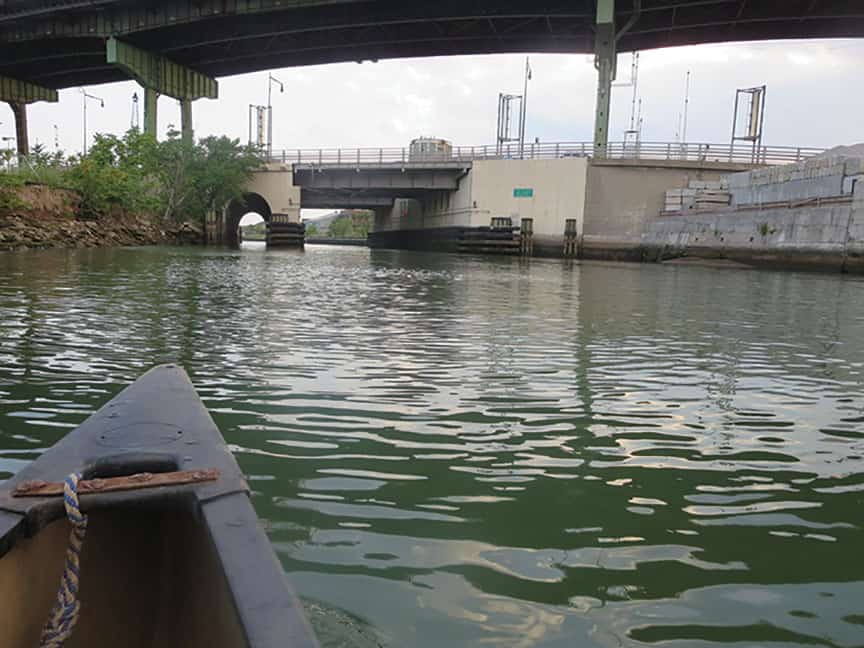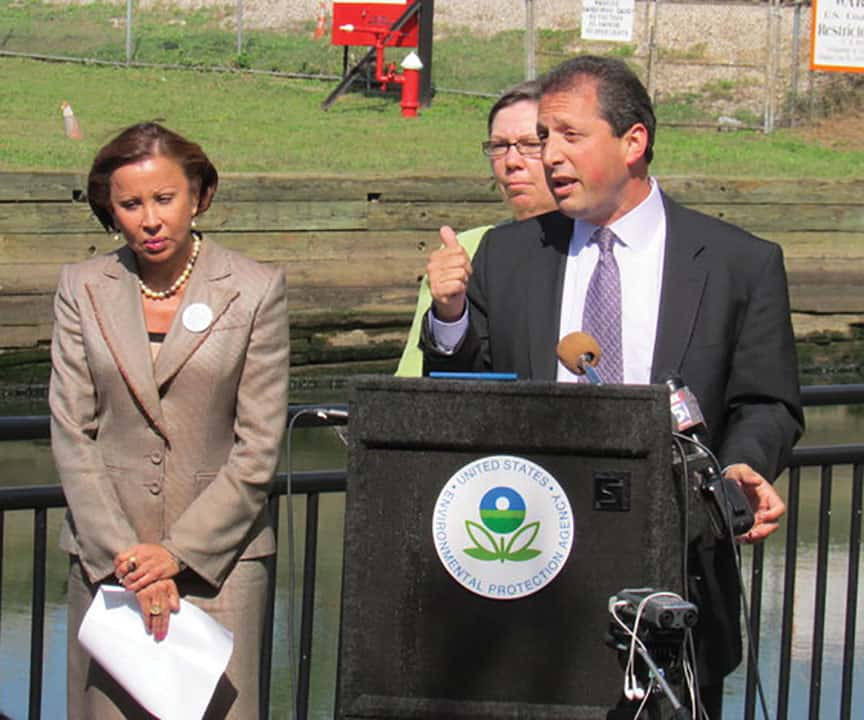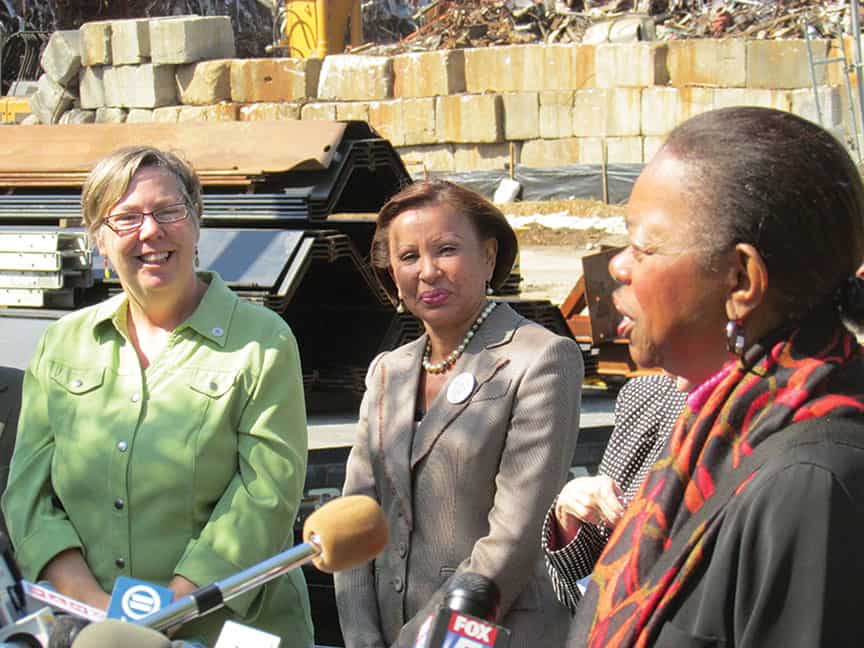It is no secret that the Gowanus Canal has been a polluted mess for over 100 years. It should seem that everyone would be on board with a plan to repurpose the canal into a clean body of water, suitable for fishing, swimming and never be a health hazard. A nearby apartment, old or new, looking out over a bucolic, nature filled scene could be wonderful. Anyone would have to imagine this as preferable than the sight of human sewage traveling down the canal following a storm.

The Environmental Protection Agency (EPA) has been given the task of managing the canal cleanup, after the Gowanus was designated a Superfund Site in 2010.
There are two main pollutants that need to be cleaned up – the sewage and the toxic chemicals that were produced by nearby industry, especially the Gas Tanks that supplied natural gas for lighting and heating until the 1970s.
By law, the federal government does not pay for Superfund cleanups. Instead, they determine who was responsible for the pollution and those entities pay. In Gowanus, the two largest such clients are the gas company (National Grid), and the City of NY, who has used the canal as a sewer whenever the pipes leading to the sewage treatment plant overflow with rainwater.
In addition to cleaning, the prevention of future contamination is part of the remedy. It wouldn’t make much sense for a company or municipality to pay to cleanup something only to have it become recontaminated.
With this in mind, the EPA has directed the City of New York to build two large tanks which would temporarily hold the excess sewage until the waters subside and the path to the sewer treatment plant is clear again.
One might think that two government entities might be working together for the common good. Wrong.
NYC has always fought the EPA. It urged less extensive and less expensive measures which would take less time. In a 2009 news item about the city’s alternate plan, the NY Times wrote “officials in the Bloomberg administration argued that a Superfund designation could set off legal battles with the polluters and defer completion of the cleanup for decades.”

Ironically, it is the City itself that has become the major litigator – threatening to delay the full scope of the cleanup in a battle over one of the retention tanks. In 2014, the city hired a Philadelphia law firm, Manko, Gold, Katcher and Fox LLP whose clients consist largely of private corporations such as chemical companies, oil and mining and utilities who are dealing with regulatory agencies such as the EPA.
In June, 2014, Robert Fox of Manko, Gold responded to an EPA demand for the city to speed up progress on the retention tanks with a ten page letter full of objections – some nitpicking – some major. It attacks the EPA’s Record of Decision (ROD) issued in September 2013 which lays out plans for the canal cleanup, and was only finalized after a long public commentary period in which all objections were considered and explained in documents available on the EPA website. “The ROD remedy is based on inadequate information and lacks scientific support,” Fox writes. He calls the EPA site selection “arbitrary, capricious, not otherwise in accordance with law.” And “There is no basis under CERCLA (the Superfund Law) for requiring a 58-74% reduction in CSO discharges.”
Because the Federal EPA is sovereign over the City, by law the City must obey the Superfund decisions. Which is why the letter concludes: “The City intends to continue to cooperate with EPA in implementation of a remedial decision that is based on sound science, in compliance with CERCLA and the NCP and on a schedule that is feasible and consistence with City procurement and other rules.”
This can easily be interpreted as saying we will challenge the need for retention tanks and the EPA’s schedule for as long as necessary, including in court if need be.
The EPA has required the City to place two retention tanks along the Gowanus. One would be around the middle of the canal, and the other at the north end. The controversy has been over the top, larger tank. The EPA’s position is that the logical siting would be underneath the swimming pool in Thomas Greene Park, which is close to NYCHA’s Wyckoff Gardens Housing Development, at Second Avenue and Degraw Street. The park was once a methane gas Manufacturing Plant, and a large pool of toxic coal tar sits directly under the pool, and is slowly migrating downhill towards the canal.
The pool has to be dug up and the coal tar removed. The park will be closed for as long as that takes, and the EPA has ordered a temporary pool to be built in the neighborhood for as long as the park is closed. They have actually surveyed the neighborhood and found a number of potential sites for a pool.
Since the pool has to be dug up, and the park sits on city owned property, the EPA thought it the logical place to site the tank. The City wouldn’t have to pay for digging a hole – it is National Grid who bears responsibility for the coal tar, and they will be digging the hole. The City wouldn’t have to pay a nickel for land acquisition and when all is done, it will present to the community an even better Thomas Greene Park.
Instead, the City says it would rather pay upwards of $100 million and use eminent domain to seize property across the street from the park. They would likely face a drawn-out lawsuit from the current property owners. They would have to pay for digging a giant hole adjacent to the canal. The EPA worries that such a hole would damage the integrity of the bulkheads, flooding the hole and making the building of the cement tank impossible, causing further delay as another site would have to be found.
Protracted negotiations between the two parties have gone long past the initial EPA deadlines – threatening the timing of the canal cleanup.
The question Brooklynites must ask is why is the City at loggerheads with the Federal Government, whose intention is simply to create a Gowanus Canal free of poisons and sewage waste – and to keep it that way.
One conclusion is that the City, despite losing the battle over the Superfund designation, is still fighting it, despite DEP’s public claims to the contrary.
They say that building the retention tanks would cost hundreds of millions of dollars. In the meantime, the City just announced that construction will start in May of an upgraded storm sewer system for Gowanus that will cost them only $52 million. New catchbasins will divert rainwater from the sewers and port the cleaner water into the canal, reducing the volume of rainwater flooding the sewers by 50%.
In 2014, repairs were completed to the Gowanus Canal flushing tunnel. The original problem with the canal was that the water was stagnant, coming in from Gowanus Basin and ending between Butler and Douglass.
The tunnel was built in 1911, connecting the north end of the canal to the waterfront at Columbia Street. That never worked too well. It is said that shippers on the canal conspired to sabotage the pumping station because the currents made it harder to operate the barges.
The NYC DEP recently completed enlarged and repaired the tunnel and its associated pumps at a cost of $177 million.

Perhaps the law firm of Manko, Gold, Katcher and Fox, LLP, representing New York City, will claim that the retention tanks are unnecessary, or at least not worth the cost, saying that the improved flushing tunnel, combined with the installation of new catch basins and pipes will do a good enough job.









4 Comments
I can understand why the industry owners in this area dont want it cleaned up, but the residents? Why don’t the residents speak up and ask the City to act in their best interests and clean the site.
Fancy new condo on the Gowanus. Do they like poo in the back yard?
I have read comments from Red Hook Residents that they do not want the dredging tanks in Red Hook and resent the choice of their more under served neighborhood as the site for the dredging caps. A bit of a social justice insensitivity. This was 2013 and I can’t find any followup from the Red Hook residents anywhere.. any journalists out there following that? Perhaps the author could follow that string instead of assuming it is the City as to why it isn’t moving forward.. The City, with this different administration than when this project started, is trying to listen to the communities as the prime stakeholders..but can’t find mention of the tank site placement .. maybe you can find it… see http://report.bridginggowanus.org/exec-summary-background/
I would like know if Red Hook Residents are being heard on that aspect of the Canal Cleanup…
This was a story about retention tanks to be built in order to alleviate a sewer problem in Gowanus. It has nothing to do with Red Hook. What you are referring to is a proposal to place dredged material in Red Hook (after it was detoxified). This was just a proposal, and subject to public comment. The public comment was against the plan, and therefore it is not being taken up by the EPA. The Red Hook Housing population was sold a bill of goods by the private property owner who stood to profit from the proposal – mainly having to do with local jobs. So if anything, you might say that the residents of the Red Hook Houses, or at least some of their leaders, were for having dredged materials in their neighborhood.
It seems you are mixing up the two controversial (thus far) elements of the Canal cleanup.